Mentone Football Club (1904-1915)
The demise of the original Mentone Football Club in 1897 left a gap in the town’s life during Australia’s Federation era. It is hard to explain why the original club went into recess but just as hard to discover the details of its re-birth in 1904 and its fortunes during its first couple of years.
The Moorabbin News reported on March 26 1904 under the heading ‘Football’ that a meeting was held at Mentone cricket pavilion the previous Monday to take the necessary steps to form a club for the coming season. The meeting, under the chairmanship of J.D.Morrison, elected a committee comprising F. Cooper, W. Blore, G. Pepper, D. Morrison, L. Canty and P. McCoy. At the meeting it was also decided to charge club members 3 shillings and 6 pence for subscriptions and that the club colours would be black and white. Mentone Cricket Club offered to let the club use the Recreation Reserve for 30 shillings per season and this was accepted along with a decision to enter the Brighton-Moorabbin competition. Two of the committee attended a meeting of the Brighton-Moorabbin Association the following evening.
A week after the first meeting, described above, the club met again. The local paper described the attendance as moderate and the reported proceedings indicated a lessening in enthusiasm after just a week. The entry into the Brighton–Moorabbin competition could not go ahead according to those who had examined the proposal. This was because several good players could not be obtained because they had thrown in their lot with other clubs.
There is evidence that some of Mentone’s young men were playing elsewhere. F. Scudds, A. Cowell and W. Cowell were in the Mordialloc team during 1904. The Cowells were senior or recent students at Mentone College and Scudds was the son of Mentone Hotel licensee, Frank Scudds. Young Scudds captained the combined ‘Southern District’ team that played against St Kilda in aid of the Carrum Relief Fund during 1904 and several times the press reports credit him with accurate goal shooting and clever play.
What happened to Mentone Football Club after the inaugural March 1904 meeting is a mystery. At the end of April a report of a ‘scratch match’ among Mentone footballers at the Recreation Reserve states that there was ‘useful work’ and some ‘promising players’. It went on to say the secretary was concerned about the slowness of members paying subscriptions. For the rest of 1904 and all of 1905 there were no reports of Mentone football. The club may have folded up temporarily. On the other hand it could have continued in an informal way, playing matches outside the regular competition against other groups organised as ‘social’ days. These may not have been reported in the local paper. My feeling is that the club went into temporary recess because in those days any small event in the town’s life, especially a visit from an outside sporting team, was usually reported in the Moorabbin News
The next report of Mentone Football Club came in early April 1906. The Mentone Junior F.C. asked the Moorabbin Shire Council to grant it the use of the Mentone Recreation Reserve for the season. The Council deferred the decision for a fortnight but then gave its assent using its recently acquired authority as owner of the reserve. The old Mentone Recreation Company had gone broke and the Shire had taken over the whole block: oval, park, tennis courts, Recreation Hall and Skating Rink. The football club got its lease and it has been there ever since.
Another meeting in the cricket club pavilion (on the site of the current one, but in reality a rudimentary shed) formed a new committee with Frank Scudds as president, J.J.Rogers and T. Mewett vice presidents, C. Caudwell captain and C. Mewett secretary. The members voted to enter the SCJFA (Southern Commonwealth Junior Football Association). This competition was a rung lower than that comprising the older local football clubs in the Brighton-Moorabbin area known at the time as the Commonwealth Football Association.
The season started disappointingly. The first match saw Ellindale Rovers (from Ormond district) kick 9 goals 14 behinds to Mentone’s 2 behinds. The report said simply that Mentone was beaten owing to some players not turning up. It implored the players to be present on time at Mentone railway station for the next game against Brighton Presbyterians as the drag leaves at 2-15. (A drag was a heavy four-wheeled vehicle with fitted seats, usually pulled by four horses). Apparently they all turned up because Mentone won 8-13 to 3-9. These teams met later in the season and Mentone again won easily, but that was the extent of the club’s on-field success as it lost its eight games against the other clubs in the Brighton area.
In 1906 there seems to have been an amazing difference in the atmosphere at games against various clubs. Two games illustrate this. When Mentone played Brighton Juniors at Hampton the report in the Moorabbin News was headlined Match ends in a Tumult. The game was rough and full of ill feeling on the part of the Brighton team, according to the reporter (who seemed to take Mentone’s side in the spat). At three quarter time the Brighton captain ordered a team line-up and a player count. The reporter stated that the Mentone captain had mistakenly played the wrong number of men from the first quarter, so Brighton team members told their opponents they were protesting and claiming victory. They stood opposite the Mentone team and commenced making the most awful noises imaginable which sounded more like a group of savages than a body of footballers. Mentone players took these insults in exemplary spirit according to the reporter who accused the Brighton captain of unsportsmanlike cunningness, apparently for not simply warning his opposite number of the breach early in the game. Mentone had been two points ahead when the game was called off.
Not all the games of 1906 were like the Brighton Juniors fixture. On June 2 Sandringham footballers came to Mentone and the encounter with the locals was a much more enjoyable one. Here are some words from ‘Half Back’, the News reporter:
The Sandringham lads rolled up in strong force, driving over in drags and other conveyances. The drags looked very stylish, being decorated with Union Jacks, the colours of the club, and the Sandringham boys are to be congratulated on the uniformity of their colours--loyal ones at that. The report said that all players wore jumpers of the same colour with a Union Jack on the back! The Sandringham supporters also waved Australian flags. The game resulted in a win for the visitors, 2 goals 24 behinds to Mentone’s 1-7, despite inaccurate kicking and C. Caudwell (Mentone) snapping the first goal of the game. After the game there was a repast for the teams (probably in the Skating Rink adjacent to Mentone Oval) and speeches, followed by three cheers being offered by the opponents for each other. Then Sandringham’s convoy of horse-drawn drags and carriages headed home to the accompaniment of cheering and waving by the ladies of Mentone.
.
The return game over at Sandringham in July was an even friendlier occasion. After the game both teams and their supporters were regaled at the local hall with a meal, as well as a concert where many of the group sang songs or recited. The usual speeches of congratulation were particularly complimentary and mutually enthusiastic.
During 1906 the Mentone players included the following:
Caudwell (3), Cooper (2), Lording (2), Bungey, Pepper, Rust, King, Kelly, McCaughey, Mewett, Sherlock, Bates, Gregory, Hopcroft, Davis, Gouldthorpe, Slater, Griffiths, Miller, Davie, Blackwood, Ferraro and Judd.
On October 20 1906 the News reported on a ‘wind-up’ evening at the Recreation Hall for the Mentone Football Club after what probably was its first full season. There were various items, including a song from Clarrie Judd and the playing of gramophone records. Cr Frank Scudds presented the prizes and told the players to avoid cigarettes, long beers and professionalism. He said they should play for the love of the game and the club. It had been a successful year even though they had not won a premiership, was his assessment as he handed trophies to McCaughey and King for goal kicking, Miller for consistency, and F. Cooper who won the Ladies’ Prize. Then the hall was cleared for dancing.
The year 1907 brought a complete change in the way Mentone Football Club conducted its season. Apart from the first game against Sandringham the club played none of the teams it had met the previous year. Mentone played more than a dozen matches, some being ‘return’ games. It seems that Mentone dropped out of the junior association and played ‘social’ games against a wide range of teams, most of them being social clubs attached to companies and other organisations.
Mentone’s first game against Sandringham was reported in Moorabbin News on
April 27. Mentone lost by nine points but the report concentrated on other matters. The team arrived late (at 3p.m.) and players ran on to the field dressed in a variety of attire, some with long trousers, others with singlets, and most with jumpers of various colours. Despite this disappointing start to the season Mentone had good players in the Caudwells, Lording, Stuart, Bourke, Kelly and little McCristal who impressed with his elusiveness on the forward line. He was the son of the Mentone College principal.
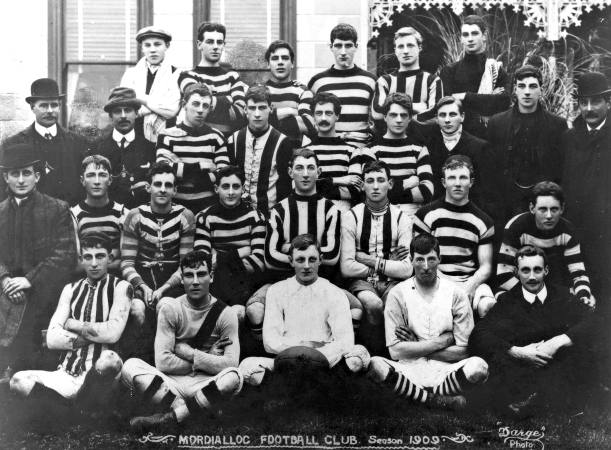
Members of the Mordialloc Football Team 1909. Courtesy Moorabbin Historical Society.
For the rest of 1907 season Mentone played games, mostly at home, against the following array of teams: Richmond Congregationalists, Clifton Social Club, Hawthorn Athletic Club, Melville and Mullen & Co, Richmond Ramblers, Melbourne Swimming Club, J. F. and H. Roberts & Co, E.L. Yencken & Co, Camberwell Ramblers, Ball and Welsh, and lastly, Victorian Railways. These were social games where the teams paid a visit to Mentone for sport followed by a sojourn in the Skating Rink next door for socialising.
Mentone won at least ten of these games (not all the results were printed), but the season was not without incident. Melville & Mullen’s side was a tough outfit that had ‘ring-ins’ from other clubs who came with the intention of playing rough football. They beat Mentone by seven goals and went the bash as well. The Moorabbin News reporter did not see the game as he confessed to going to a VFL match that Saturday where he saw fisticuffs. His spies at Mentone told him he could have seen that at the local game where Parry of Mentone was attacked and, being a Britisher, retaliated causing a nasty incident to unfold. In other weeks one team did not turn up and another game had to be called off half way through the last quarter when it got too dark. In a game against the Richmond Congregationalists three Mentone players had to leave in the final term to catch the train so Mentone put everyone on the backline to hold on for a two point win! The report said the Richmond players were a respectable body of young fellows New players in 1907 included Nichol, Davies, Vinning, Lannan, Cartledge, Melville, Lynch and Parry.
Heartened by many wins in 1907 Mentone decided to join a regular competition in March 1908 after a meeting that appointed the loyal Col Caudwell and Charlie Mewett as secretaries. The club had been in danger of losing Scudds and Caudwell who were training with Cheltenham but Mentone club joined the Brighton-Moorabbin competition and these players returned. The team trained on Wednesday and Friday nights, its improved fitness allowing the club to run Moorabbin close in a practice match. Mentone College boy, Tom McCristal jnr, showed form in another scratch match against Oakleigh but Mentone struggled when the real competition games began, losing heavily to Sandringham, Ellindale (Ormond) and Dandenong. On the week of its bye the club played a practice match, ‘players’ versus ‘non-players’, and the former only scraped a narrow win. After another two losses Mentone faced the second half of the year winless and demoralised, having lost to Sandringham by over 20 goals in one game where only eleven regular players turned up, necessitating the recruitment of juniors and supporters to fill up the list.
A general meeting was called and it was announced that Bert Sharpe, an ex-captain of Fitzroy, was to be appointed captain. Who recruited him is not recorded. Bert was probably well past his best playing days but he provided leadership and know-how. The change in the team performance was immediate. Mentone went down to Sandringham by only ten points, and then defeated Dandenong by four points in a thriller where Sharpe’s tactics mobilised the skills of Scudds, Bungey, Caudwell and others to clinch the win. This success was followed by a seven-goal beating of Oakleigh where Dean kicked 3 goals and young Ernie Jones notched two. The Moorabbin News began to enthuse about the new spirit, praising the efforts of the Caudwell brothers, Jim Bourke, Dan Bourke (a college boy), Gouldthorpe, Scudds, Jones, Parry, Stuart, Moon and McCormick. Though it lost the last two games, Mentone was not disgraced as it went down by only four points in the final match to Ellindale, the eventual premiers.
H.P. Peterson entertained the players and supporters at his ‘Clifton Tea Rooms’ after the season. Peterson was new to the town. His timber double shop had a confectionery section and a small eatery as well. It was located in Mentone Parade opposite Kilbreda and remained a quaint reminder of Edwardian days for over half a century until Peterson retired. The 1908 football wind-up function began when Cliff Caudwell played an overture on the piano and then all drank the health of King Edward VII. The new captain, Sharpe, spoke of the need to remain dedicated and said he hoped to continue even if he was a player of over ten years wear and tear. Mr Dunn of the Moorabbin News was present and given praise for his reporting of Mentone games. It was suggested that the club should enter the Commonwealth Competition in 1909 with a set of jumpers in uniform colours. (It is not clear what colours Mentone players wore up until this time. One early reference was to ‘black and white’ but in 1908 a report stated that Fred Scudds and P. McCaughey will don the blue and white today. A 1909 team photo shows Mentone players in all white jumpers but in 1911 the team began to wear blue and red and these colours of the Melbourne F.C. were worn until the club changed to black and yellow in 1921). The 1908 season ended on a great high with singing and gramophone records adding happy tones as the players ended their celebration at Peterson’s. Then Mentone challenged local rivals, Mordialloc, to a match later in September and won easily, 8-11 to 4-5.
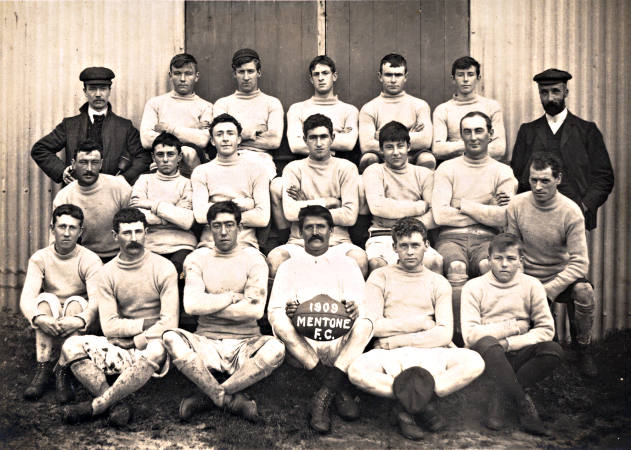
Members of the Mentone Football Team 1908. Courtesy Mordialloc and District Historical Society.
In March 1909 Mentone Football Club held its general meeting in the Skating Rink, optimistically adding Frank Scudds (hotelier) and Vinning (the local grocer) to the committee. It was decided to hold a grand fund-raising concert so that new uniforms could be purchased and showers installed in the change rooms at the Recreation Reserve. As well as Scudds and Vinning, the committee had Mewett, Sharpe, Caudwell and Canty (the local policeman) with Dean as president. All looked forward to the new season and this enthusiasm grew when the Federal Football Association was formed after a meeting on April 10 at the Small and Edwards estate agency, the triangle of offices in the town’s heart. At this meeting H.P. Peterson, Mentone’s confectioner and tea rooms proprietor, and F.McCart joined a small committee under the presidency of Cr F T Le Page that formed the new football competition. In its first round the Federal fixtures were Moorabbin v. Mordialloc, Glenhuntly v. Cheltenham and Ellindale v. Frankston. Mentone had a bye. At the next meeting in Peterson’s tea rooms Elsternwick was admitted and it played Mentone in the first round.
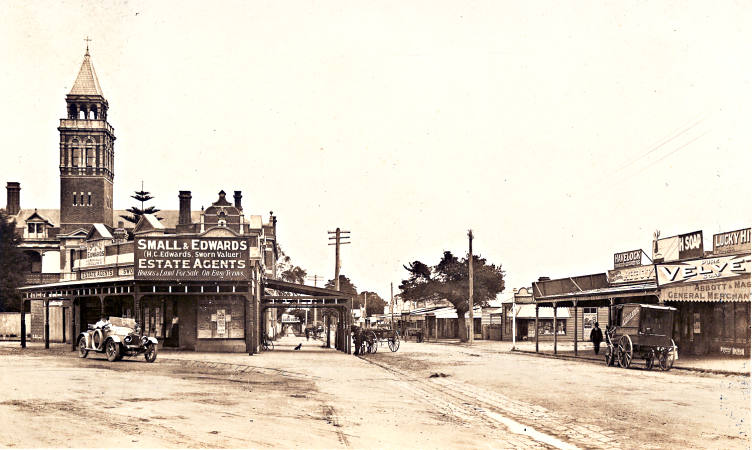
Small and Edwards, Estate Agency, Mentone Parade, Mentone c1920s. Courtesy Mordialloc and District Historical Society.
Mentone lost its first game and by July had lost seven more. The club had a good win over Glenhuntly but received several thrashings by over ten goals, the worst defeats being against neighbours Cheltenham and Mordialloc. In the latter part of the season the club managed one close victory against Moorabbin but lost all the remaining games to finish with a 2-12 win-loss ratio. Cheltenham went on to win the first Federal flag, convincingly beating Ellindale by five goals in the final.
Many of the Mentone players from 1908 featured during the year together with newcomers Rust, Hancox, Price, Gayton and Hammond. The inspiring Sharpe of the previous year seems to have disappeared. Perhaps he moved away from the town.
It became clear during its first year in the Federal Association that Mentone did not have the players to match the standard of rivals up and down the Frankston line. In 1910 Mentone pulled out of the competition despite an early meeting that appointed a large committee. At that meeting it was stated that Mentone was one of only two clubs in 1909 that did not have a player reported for rough play. This virtue did not help. The Federal Association admitted Victoria Brewery in 1910 and its players and supporters began to make ‘rough play’ a feature of their fixtures. During this year ‘Mentone Juniors’ played a social game against Cheltenham, losing by only two goals, but little else was reported about the club. One can only surmise that the club went into semi-retirement. Some of its players, notably C. Caudwell and Parry, transferred to Cheltenham. It should be said that Mentone did claim a premiership that year when Mentone College boys defeated Hawthorn College on the MCG to win the B section of the Schools Association competition. The college won by nearly four goals with Tom McCristal junior kicking three and other good players being Narik, Pimblett, Newton, Gavan-Duffy and Gorman, mostly boarding students from elsewhere in Victoria.
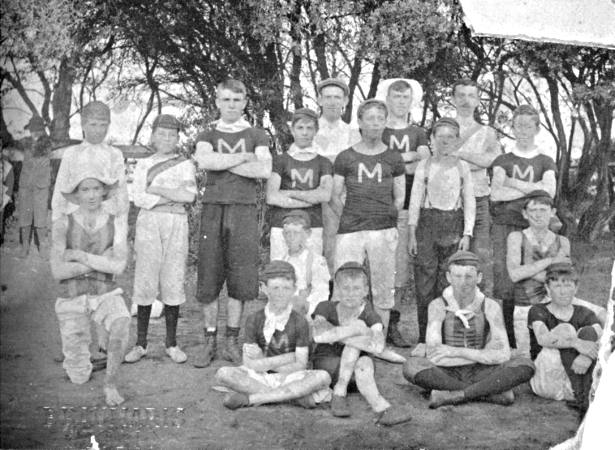
Mentone College Football Team 1909.
From early March 1911 the Federal Association committee and delegates met several times at Peterson’s tea rooms in Mentone and split the competition into two grades. Mentone entered the junior grade while the senior grade had the tough sides: Moorabbin, Cheltenham, Victoria Brewery and Carrum.
In the junior section six teams entered: Cheltenham, Moorabbin, Mordialloc, Mentone, Westbury (St Kilda area) and Windsor. Players were probably limited to those under 21. It is clear that Mentone had a policy of encouraging teenagers to take part as McCristal, the Mentone College Headmaster, was chair of the selection committee. One should not over-emphasize the importance of football at the time; a press report stated that the Council had given free use of the Recreation Reserve to the Mentone club (and the ladies’ hockey club), but with the rider that this applied when the ground was not needed for picnic parties.
Mentone Juniors began well with a six goal win over Cheltenham, a one point loss to Moorabbin and a win over Westbury. After that the team suffered a series of defeats, some by very small margins, in a very competitive effort right through the season to finish fourth. Cheltenham defeated Mentone by just 2 points in the semi final with the best players for the losers named as Cook, Newton, Caudwell, Stott, McDonald and Champion. At the trophy night in Peterson’s rooms Mentone players to receive awards were C. Caudwell, R. Stott. W. Penny, S.Cooper and F. Fitzsimmons.
Meanwhile the Federal Association had to deal with some big problems. At the Cheltenham-Victoria Brewery final no fewer than five police officers attended the game in the expectation of unruly behaviour. The Brewery supporters had caused brawls in several games and their players ‘went the bash’ as well. This was not all. In 1910 Victoria Brewery won the premiership and received the shield presented by parliamentarian, Agar Wynne. They were expected to return it the next season for presentation to the premier team. The Brewery, despite repeated requests, would not return the trophy and were fined two guineas when they finally brought it at season’s end. Cheltenham beat them in the final. The Federal committee also expelled Westbury for various offences and rubbed out three Windsor players for a whole season. 1911 had been a rough season, with spectators sometimes invading grounds to join fights among players. Umpires struggled to keep control. One police constable, when asked by an umpire why he would not intervene in a donnybrook during a game, told the ‘man in white’ that his hopeless umpiring had caused the fight, implying that he could break it up himself. At the time few grounds had fences around the boundary so spectators could easily get in among the pack of players scrimmaging near the fringe.
On April 6 1912 Mentone Football Club held its pre-season meeting with glowing reports of the previous season’s efforts. Scudds became president again and Sir Matthew Davies accepted a vice presidential role, having returned to live in Mentone Parade after fifteen years living elsewhere since the land boom collapse. Mentone was still a junior team. Despite a few promising games and newcomers in Tom McCristal junior, George Fricker, Harry, Finn and Hurley, the team managed only two wins from fourteen games and ended the season by giving a walkover to Mordialloc when not enough men could be mustered to form a team.
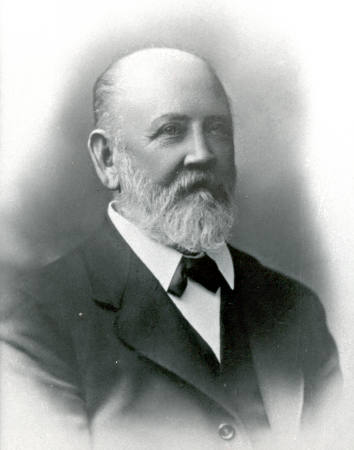
Cr F M Scudds 1907. Courtesy Kingston Collection.
The Moorabbin News offered a gold watch to the season’s top player in senior and junior divisions. This award went to the player with the most votes from the paper’s readers, who had to submit each vote on a form cut from the News. In this way the local paper boosted its sales and it stirred up interest with progress counts each week. A. Biehl (Chelt.) ran away with the senior award while P. Woff beat Vic. Jones of Mordialloc for the juniors’ watch. Jones later became a fine Prahran player in the VFA and, later still, a part of the Jones Brothers legendary hardware business in Mentone for over fifty years. In the Federal finals the Brewery players bashed their way to another flag against Moorabbin and in the juniors Mordialloc and Elsternwick played a draw, with Vic.Jones starring in the replay to give Mordialloc the flag by one point!
The Federal Association, early in 1913, rejected a request to become a feeder group for Brighton Football Club which was joining the VFA and wanted a steady source of recruits. H.P.Peterson was involved in discussions with the Brighton club which wanted the Federal to change its name to the ‘Brighton Association’. Peterson asked if Brighton’s ground would be available for the finals free of charge but was told that Brighton would want a third of the ‘gate’ and would charge other fees. The Federal committee turned its back on Brighton and also threw Victoria Brewery out of the competition while allowing them to keep the Premiership Shield which they had won twice. They probably would have had difficulty getting the brewers to return it anyway!
Amid discussion about the evil of player payments, which all officials decried but some clubs obviously indulged in, the season began on May 3. Mentone returned to the senior grade, playing away against Black Rock in the first game. Players were told in the columns of the Moorabbin News that the team would be picked at the ground and that a drag leaves the station today at 2 p.m. Black Rock won by six goals. The rest of the season was not very successful for Mentone either. The club had good wins against Moorabbin Park and Heatherton, two weak teams, but was soundly beaten by the better clubs in many one-sided matches. Cheltenham won the flag.
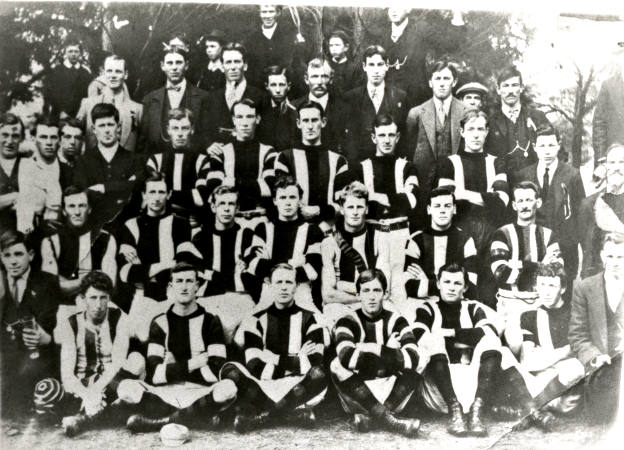
Members of Cheltenham Premiership Football Team 1913. Courtesy Moorabbin Historical Society.
In one game Mentone and Carrum played on Mentone Oval with half the surface under water. With driving rain still falling the captains agreed to cut playing time to four quarters of fifteen minutes each. Apparently one Carrum player took the field in a bathing suit while another incident was indicative of football’s informal state in 1913. Mentone attacked its goal and a forward drove the ball through the goalmouth to see it marked by a man in a coat and long trousers. The umpire signalled a goal and returned to the centre to bounce the ball but was informed that the man in the coat was not the goal umpire, or a spectator, but the Carrum full back! The goal was cancelled and Mentone lost the game by nineteen points. Mentone wound up the season with a Smoke Night at the Recreation Hall where the proceedings began with members proposing many toasts: to The King! to The Game! to The Federal Association! to Kindred Sports! to The President! and so on. Good players in 1913 included Griffiths, Lording, Cooper, Fricker, Coventry, Blackwood, Rust, Chenney and Casey.
Mentone Football Club remained in the senior grade for the 1914 season but improved little on the previous season’s efforts. It won five games and lost ten, finishing third last. Once again Mentone could beat Heatherton and Moorabbin Park but received unmerciful thrashings from Cheltenham, Moorabbin and Middle Brighton which had remained in the Federal after the Brighton VFA team had been formed. Moorabbin won the flag in A Grade. Mentone’s captain was Maskell and many new names appeared in the team. Early in 1914 the team included Franklin, Morris, Newton, Wolsley Cooper, Martin, E. Jones, Coventry, Grainger, Smith, Penny, Morgan, Haase, Flavin, Muir, Mattheson, Micklejohn and Damason. It was reported that Mentone Oval would no longer host the finals as the Federal committee had moved them to Cheltenham because the Mentone ground lacked a fence around the playing arena. This decision came because it had been another troubled year with some games called off after unruly crowd and player behaviour. Mr Balding of the Mentone committee tried to get the Federal finals played at Mentone, promising improvements, but to no avail.
By the time the football season began in 1915 Gallipoli had become a name Australians would never forget and the Federal announced that at least 150 of its players were in the services, many overseas. Despite this the competition went ahead with two grades. Mentone dropped to B Grade with four other teams. The team, known then as the ‘Red Legs’ because of its Melbourne F.C. colours, managed a couple of wins against Heatherton and a rare victory over Cheltenham, but despite close-fought games it could not beat Glenhuntly or Black Rock/Sandringham. Its best effort was a thrilling draw against the latter in the last game where Lording kicked four goals and Droop, Townsend, Glenfield, Jones, Morey, Grainger and Coventry were good players. However, the war dominated people’s lives and football slipped down the priority list. When 1916 came around the bitterness that began to emerge about army recruitment grew to the point where the sport was seen as an unpatriotic luxury that could not be justified while young men were dying in Europe. Strong views were expressed that able bodied men should enlist and not stay home to enjoy sporting pursuits. The Federal competition was suspended.
During 1916 and 1917 Mentone juniors (composed of teenagers too young to enlist) played a couple of social matches, one against Cheltenham which they lost. Some took part in a scratch game against Langwarrin Military Camp but organised team sports largely disappeared until after Armistice in 1918.
The Great War changed society forever. The football competitions in the 1920s were destined to become more strictly organised and ‘professional’ than in the Edwardian period. In the pre-war period there was a much more casual approach and evidence of an almost picnic atmosphere at times. At other times an atmosphere of ‘stoush’ prevailed. Players’ uniforms were not always as standardised as we know them, and grounds were rough, generally being unfenced. It should be said that the game at the local level in the early 1900s was very popular, so that long descriptions of some matches, quarter by quarter, were published in the local press. Despite the presence of the VFL and VFA sizeable crowds attended local games, especially the finals. The Moorabbin News ran a weekly competition for its readers in 1914, where the person who could name the highest score in both Federal grades on a Saturday would win ten shillings. Mentone was in the centre of all this. Its ground was a finals venue for many years. The Federal Association was born at a Mentone meeting. H.P.Peterson was a leading committee man at Mentone from the time he arrived in the town in 1908 and he was a prime mover in setting up the Federal competition. His dedication to the local game was remarkable. He never played the game but spent a lifetime in football (and cricket) administration. It should be recorded that he played in a cricket premiership for Mentone in 1910-11. ‘Old Pete’, as he was later nicknamed, offered his premises for football and cricket functions, served on committees, donated trophies and was at every Mentone Oval game until the 1960s. The football club gave him little on-field success to enjoy in the early days.
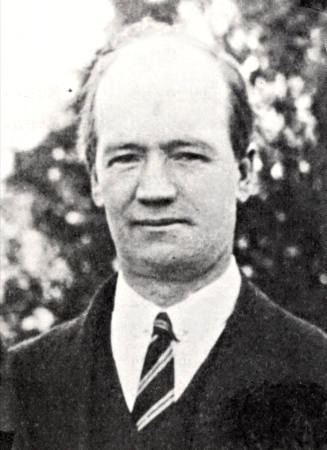
H P Peterson.
Mentone Football Club’s first three decades of existence brought no great glories and many disappointments. After the first team was formed in 1889 there were dramatic changes in fortunes over the years and the club went into recess a couple of times. There were no premierships. In fact the club played in only one final series after these were instituted and lost that semi-final narrowly. The club struggled to maintain continuity at committee level, though H.P.Peterson, Frank Scudds and one or two others were very loyal. After 1900 Mentone had many players who performed very well and who appeared year after year, as can be seen from the above descriptions, but the team fell short of the standard needed in the local competition and could not match Cheltenham, Moorabbin, Sandringham and Mordialloc. Victories against them were rare indeed. Some of Mentone’s better players were lured to other clubs and there was a continual problem of maintaining enthusiasm. Towards the end of some seasons Mentone fell away, struggled to raise a team, received heavy beatings and even gave walkovers to opposition teams. There were calls for better attendance at training, more punctuality at game time on Saturdays and more financial support. While the team had notable victories and brilliant efforts by individual players, the period before World War One was disappointing for those in Mentone who followed the local team. The decade after Armistice would be very different at Mentone Football Club and that story is much more exciting.
